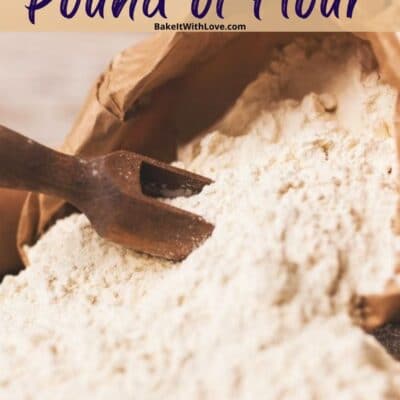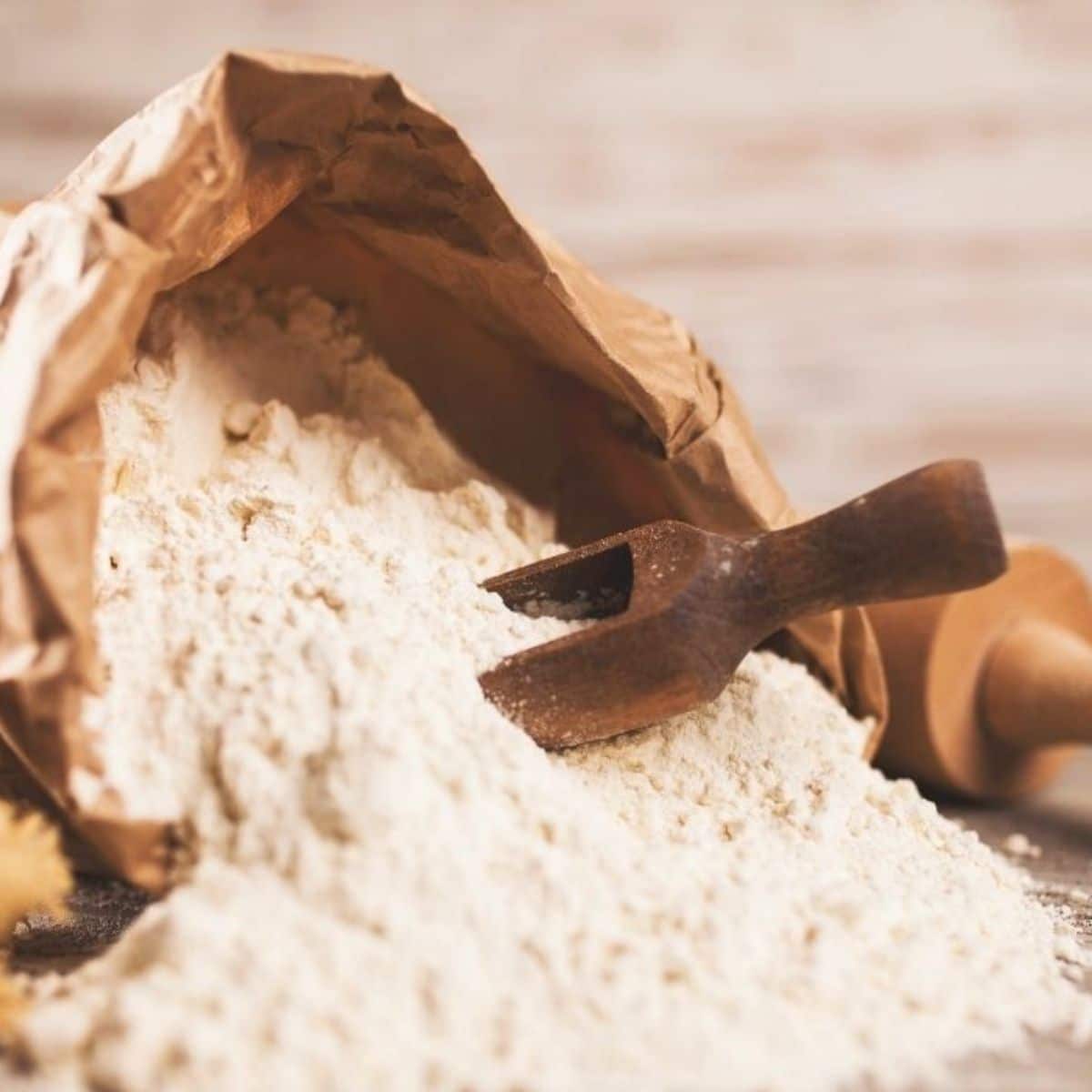1 Pound To Cups Flour

You lot may call back there is a simple answer to how many cups in a pound of flour, simply there is more to it than meets the center! Here nosotros answer that very question and offer a few tips and tricks so that you can bring your baked goods from average to amazing!

How to convert a pound of flour into cups and more than handy baking tips!
When it comes to blistering, precision is essential. Baking is a highly technical art, and getting the measurements just right is of import if you want delicious baked appurtenances.
While volumetric measurements are commonly used in baking, professional person bakers often prefer to weigh their ingredients. The reason is that weight and book are non the same, only as a cup of sugar and a loving cup of flour do non weigh the aforementioned.
Leap to:
- Why Practice You Need to Mensurate Flour?
- Using the Spoon and Sweep Method
- Using the Scoop and Sweep Method
- How Practice I Mensurate Sifted Flour?
- How to Counterbalance Flour on a Food Calibration
- Grams vs. Ounces
- Which Method Should I Apply?
- Flour Measuring Tips
- How Many Cups In A Pound of Flour?
A cup of flour, for example, tin yield a different corporeality depending on how the flour is placed in the cup. A heavy hand, a press of the flour, or a tap can cause the flour to settle at the lesser of the cup if you scoop it directly from the bag.
Meanwhile, if you weigh the flour, 180 grams will always be 180 grams no matter how you scoop it.
You can get away with a few extras when you're cooking, simply even a small measuring error when baking tin can result in a dry cake. Better blistering results can be achieved by learning the proper manner to mensurate each ingredient.
A single measured ingredient mistake is all that separates the success of a recipe from its failure.
Why Do Yous Demand to Measure Flour?
Flour is the almost mutual ingredient that is often under or over-measured. Even when using a measuring cup, you lot tin still end up with upward to 50% more flour than you lot demand if you practise information technology incorrectly.
Using the Spoon and Sweep Method
In the absence of a kitchen scale, the spoon and sweep method is the simplest and most accurate manner to measure flour or other dry out ingredients. When done correctly, information technology's almost equally precise every bit measuring by weight, if non exactly.
- Fluff the flour in a bowl. Earlier measuring the flour, loosen it with a spoon or a whisk. Aerating the flour before measuring is a good idea no affair how many times you've done it previously because it tends to settle.
- Transfer to a measuring cup for accurate measurements. You tin can employ a spoon to fill your measuring cup to the rim of the container.
- Using a straight edge tool, level the surface to an fifty-fifty pinnacle. Scrape off whatever excess flour with a knife or bench scraper and return it to the flour container.
Using the Scoop and Sweep Method
This method is another popular measuring method among abode bakers. The vast majority of home bakers measure their flour in this mode.
While this method is not incorrect, compared to the spoon & sweep method, you'll become more flour per gram if you go this route.
To use this method, all you lot demand to do is lightly scoop the flour from the purse or container. Avoid pressing the flour down. Instead, use a knife to level off.
When making a recipe that calls for multiple cups of flour, the deviation between the spoon and sweep method and using this method is approximately 12%.
How Exercise I Measure Sifted Flour?
Sift the flour before measuring it if the recipe calls for "1 cup of flour, sifted". Depending on the formulation, sifted tin be found in any role of an ingredient.
If the word "sifted" appears before the name of an ingredient, sift before measuring. If it appears after the ingredient proper noun, sift after measuring it out.
How to Weigh Flour on a Nutrient Scale
In order to avert having to use measuring cups altogether, you can relieve time and coin past purchasing a kitchen calibration instead.
The simplest way to zero out a calibration is to identify a basin or measuring cup on it and printing the "tare" button. That fashion, the weight of the bowl volition non be taken into business relationship by the scale when determining the flour's weight. So, place the ingredient into the bowl until it reaches the amount you need.
Information technology's best to use a carve up bowl to measure out the ingredients. Don't counterbalance the ingredients direct into the mixing bowl. If you put too much in by fault, y'all can just employ a spoon to remove information technology.
Grams vs. Ounces
Grams are a smaller unit of measurement than ounces, which is why grams are the preferred form of measurement past bakers. Precision is key, so a smaller unit of measurement means y'all can measure more accurately.
More importantly, ounces are a unit of measurement for both solids and liquids which unnecessarily complicates things.
Which Method Should I Use?
Measuring past weight is the nearly accurate and most reliable method. Professional bakers tin concur that this is the best method for measuring. However, if you don't accept calibration, using the spoon and scoop or scoop and sweep method is perfectly fine.
Flour Measuring Tips
We've put together some of our suggestions when it comes to measuring flour.
- Practise non sift your flour before measuring unless your recipe specifically instructs you lot to. You'll utilize far less flour than the recipe specifies if yous practice this.
- Stir or whisk the flour in the container to lighten it earlier measuring.
- Brand sure you're using a measuring cup designed for dry ingredients when you measure wet ingredients. In lodge to become accurate results, you tin't use anything other than an actual measuring cup!
- Scooping with a spoon or shaking the cup will compact the flour, so avert doing so. Yous'll go an inaccurate effect if you compress the flour.
How Many Cups In A Pound of Flour?
Now that you are well-versed in why weight is preferred to volume when measuring ingredients while baking, nosotros tin can answer the question of the hr: how many cups are in a pound of flour?
That answer is dependent on the type of flour in question because dissimilar types of flour accept different densities! As well, when flour is sifted air is introduced which alters the book. Below are the number of cups in a pound of flour for different flour types:
- Whole Wheat Flour - 3 ½ cups
- White All-Purpose/Bread Flour (sifted) - iv cups
- White All-Purpose/Bread Flour (unsifted) – 3 ½ cups
- White Block/Pastry Flour (sifted) - 4 ½ cups
- White Cake/Pastry Flour (unsifted) - 3 ½ cups
- Soy Flour - half-dozen cups
- Rye Flour - 4 cups
So why do I need to know how many cups in a pound of flour? If you know that you're going to be using 6 cups of flour for a rustic bread recipe, information technology's easier to make sure that you have enough flour at abode.
Or, to know that you need to pick up an additional 2 pound handbag at the store!
Whether y'all use a scale or a measuring cup, we hope this guide helps you amend understand the importance of measuring flour and how to do it correctly for the best results when blistering. Let us know what you recall in the comments!

Angela is an at home chef that developed a passion for all things cooking and blistering at a immature age in her Grandma'southward kitchen. Later many years in the food service industry, she now enjoys sharing all of her family unit favorite recipes and creating tasty dinner and amazing dessert recipes here at Bake It With Honey!
1 Pound To Cups Flour,
Source: https://bakeitwithlove.com/how-many-cups-in-pound-of-flour/
Posted by: lawrencelabon1956.blogspot.com


0 Response to "1 Pound To Cups Flour"
Post a Comment